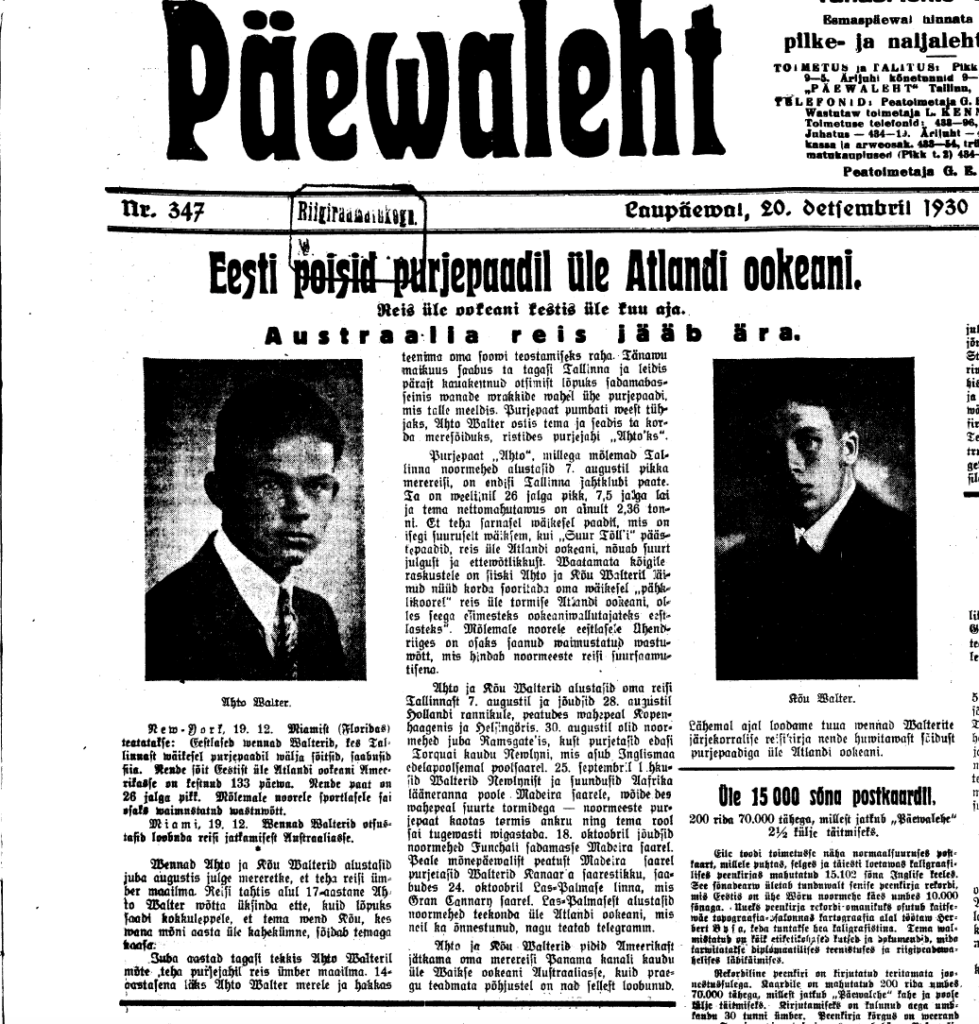Boats

Estonia passengers arrive in Miami. From left Mihkel Kõvamees, Kõu Valter holding Helme, 4 months, his wife Klarissa, and their daughters Maia, 8, and Aloha, 9. Republished in Välis-Eesti June-July 1992
estonia
The Estonia was the first Viking boat to cross the Atlantic, setting an example for dozens of refugee vessels from Sweden that would follow after World War II.
On July 10, 1945, three veteran Estonian seamen, Kõu Valter, Mihkel Kõvamees, and Bernhard Veskimeister, left Göteborg, Sweden, for England and America on the 48-foot-long (11 meter) sailboat. Valter’s wife and three young daughters were also on board.
Captain Valter was a renowned sailor who had crossed the Atlantic in 1930 with his brother, Ahto, in a 26-foot-long (8 meter) sailboat. In 1934, Kõu Valter returned to Estonia and served in the Navy. In 1944, he escaped with his family to Sweden and made two dangerous trips to Finland in his own boat to evacuate 964 Estonian refugees to safety.

Around England: Välis-Eesti newspaper reported on the Estonia’s transatlantic journey in autumn 1945
Leaving the Norwegian coast in July 1945, the Estonia encountered a rough storm in the North Sea that pushed the boat into a hazardous minefield. After dodging naval mines for three days, the crew spotted a Norwegian fishing boat using drift nets, indicating they were no longer in danger, and they sailed to Leith in Edinburgh, Scotland. Foreign ships were forbidden to land, but the Estonia’s crew was permitted to go ashore with an escort to buy provisions and charts. On July 27, high winds forced the Estonia to seek shelter in Aberdeen. Bernhard Veskimeister, who would go on to captain the Ly, which sailed to South Africa in 1948, left the group and traveled to London. From Aberdeen, the Estonia sailed through the Caledonian Canal to the west coast of Scotland.
Mihkel Kõvamees kept a log:
In Aberdeen, it is apparent that during the war people’s clothes have gotten a lot worse. There is not much to look at in the shops—they are empty. But in the evenings, taverns and bars are even more crowded than in the old days, with people drinking beer and chatting.”

Kõu Valter and his brother Ahto, were experienced sailors who had already crossed the Atlantic in a tiny sailboat when they were 23 and 19 years old, respectively. “Estonian boys sail across the Atlantic Ocean, Päewaleht, December 20, 1930.
The Estonia’s outboard engine stopped working in the Irish Sea and in the port of Newlyn, the crew repaired the outboard motor and prepared for the next leg across the Bay of Biscay, “Where,” Kõvamees wrote, “all the winds and currents of the world meet and where there are always surprises in store for sailors.”
On September 13, he reported that the weather suddenly turned tropical. One morning, the group spotted what looked like a barrel in the ocean, but it turned out to be a turtle trying to climb on top of a round iron object. Captain Valter wanted to catch the animal and make turtle soup but then realized the object might be an old mine. “We left the turtle to wrestle on and we were all sorry,” Kõvamees wrote.
On September 20, the Estonia reached Funchal, Madeira’s largest port, where they were surrounded by merchants in boats who wanted to barter Portuguese goods for clothing, which was scarce.
Before leaving Madeira on October 10, the men learned that Captain Harri Paalberg was en route aboard the Erma, a 37-foot-long (11 meters) sloop, and they left a letter with greetings. Then the Estonia set a course for America, pushed by a northeasterly trade wind.

In the Madeira islands: Välis-Eesti continued its coverage of the Estonia’s transatlantic journey in autumn 1945
“With a 4,000-mile sea voyage ahead of you, your mind is spinning,” Kõvamees wrote. “It was clear to all of us that this voyage would be a big risk. But you always have to hope for the best, and that’s what we did.”
On November 6, the trade winds died down and the air turned warm and stifling. “We sweated profusely, which made us thirsty and reduced our water reserves. In Madeira, we filled our water tanks with a ton and a half of water, deciding to use it only for food and drink. We gave up all other necessities. On a sailing boat, it is water that keeps the crew going.”
The weather in the Atlantic was favorable for the rest of the journey, and on November 20, 1945, four months after leaving Sweden, the Estonia arrived in Miami, Florida. Ahto Valter, who lived near Miami, helped the group since they didn’t have entry visas. They used their Swedish refugee passports until officials heard they had Estonian passports issued in London. “There are no better passports in America,” the officials said. Kõu Valter and his family settled in Florida. Kõvamees worked as a long-distance sea captain based in America for nine years before returning to Sweden.
Crew and passengers:
- Kõu Valter, wife Klarissa, and daughters Aloha, 9, Maia, 8, and Helme, 4 months
- Mihkel Kõvamees
- Bernhard Veskimeister (left the boat in Scotland)
